1997 PONTIAC BONNEVILLE parking brake
[x] Cancel search: parking brakePage 96 of 405
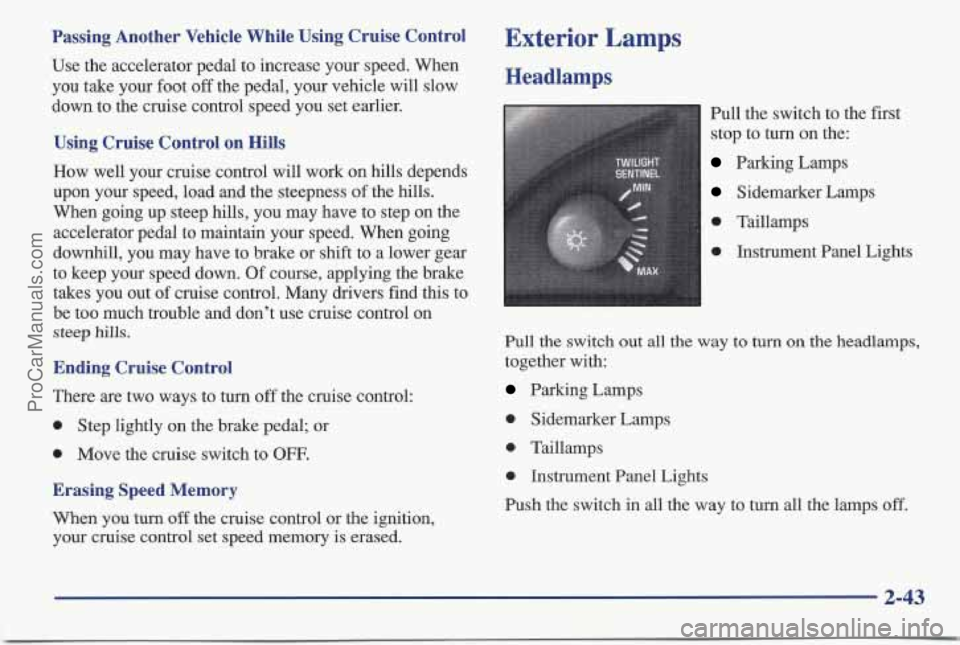
Passing Another Vehicle While Using Cruise Control
Use the accelerator pedal to increase your speed. When
you take your foot off the pedal, your vehicle will slow
down to the cruise control speed you set earlier.
Using Cruise Control on Hills
How well your cruise control will work on hills depends
upon your speed, load and the steepness
of the hills.
When going up steep hills, you may have to step on
the
accelerator pedal to maintain your speed. When going
downhill, you may have
to brake or shift to a lower gear
to keep your speed down. Of course, applying the brake
takes you out
of cruise control. Many drivers find this to
be too much trouble and don’t use cruise control on
steep hills.
Ending Cruise Control
There are two ways to turn off the cruise control:
0 Step lightly on the brake pedal; or
0 Move the cruise switch to OFF.
Erasing Speed Memory
When you turn off the cruise control or the ignition,
your cruise control set speed memory is erased.
Exterior Lamps
Headlamps
Pull the switch to the first
stop to turn on the:
Parking Lamps
Sidemarker Lamps
0 Taillamps
Pull the switch out all the way to turn on the headlamps,
together with:
Parking Lamps
0 Sidemarker Lamps
0 Taillamps
0 Instrument Panel Lights
Push the switch in all the way to turn all the lamps off.
2-43
ProCarManuals.com
Page 120 of 405
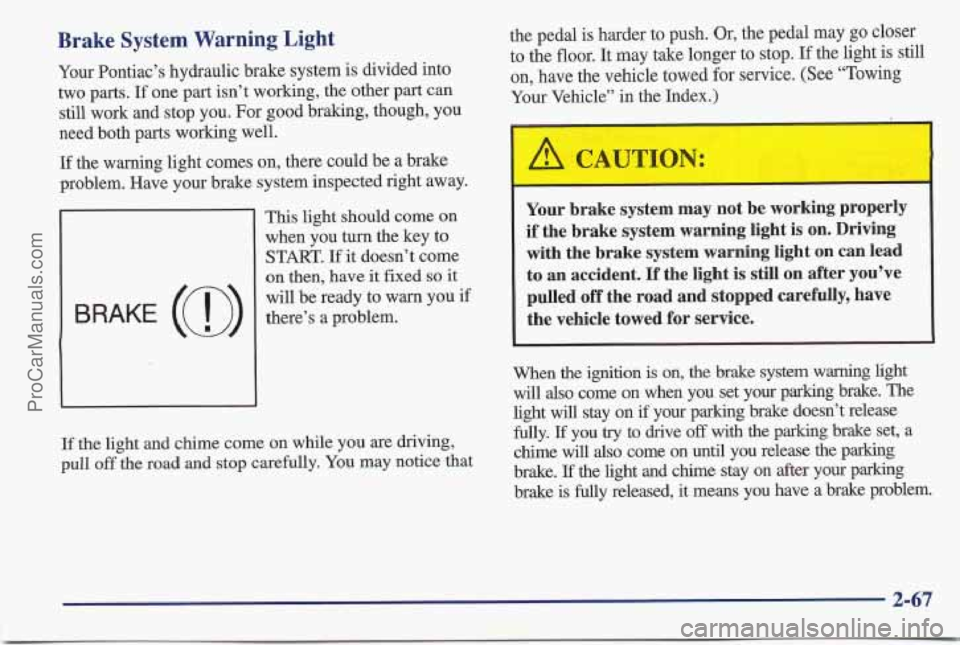
Brake System Warning Light
Your Pontiac’s hydraulic brake system is divided into
two parts.
If one part isn’t working, the other part can
still work and stop you. For good braking, though, you
need both parts working well.
If the warning light comes on, there could be a brake
problem. Have your brake system inspected right away.
BRAKE (a)
This light should come on
when you turn the key to
START. If it doesn’t come
on then, have
it fixed so it
will be ready to warn you
if
there’s a problem.
If the light and chime come on while you are driving,
pull
off the road and stop carefully. You may notice that the pedal
is harder to push. Or, the pedal may
go closer
to the floor. It may take longer to stop.
If the light is still
on, have the vehicle towed for service. (See “Towing
Your Vehicle” in the Index.)
Your brake system may not be working properly
if the brake system warning light is
on. Driving
with the brake system warning light on can lead to an accident. If the light is still
on after you’ve
pulled off the road and stopp,ed carefully, have
the vehicle towed for service.
When the ignition is on, the brake system warning light
will also come on when you set your parking brake. The
light will stay on
if your parking brake doesn’t release
fully.
If you try to drive off with the parking brake set, a
chime will
also come on until you release the parking
brake.
If the light and chime stay on after your parking
brake is fully released, it means
you have a brake problem.
2-67
ProCarManuals.com
Page 134 of 405
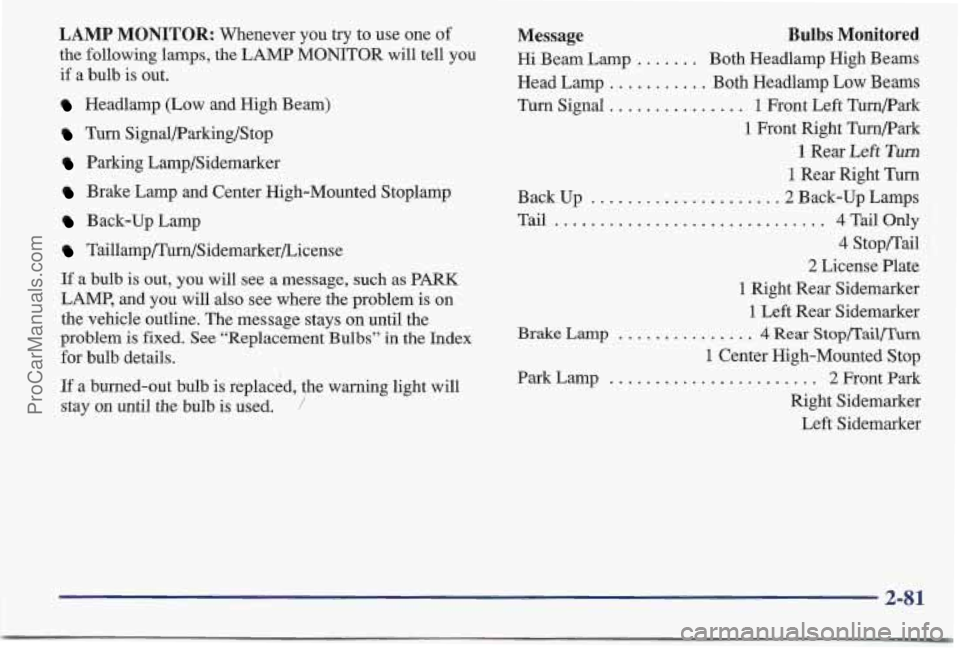
LAMP MONITOR: Whenever you try to use one of
the following lamps, the LAMP MONITOR will tell you
if a bulb is out.
Headlamp (Low and High Beam)
Turn Signal/Parking/Stop
Parking Lamp/Sidemarker
Brake Lamp and Center High-Mounted Stoplamp
Back-up Lamp
Taillamp/Turn/Sidemarker/License
If a bulb is out, you will see a message, such as PARK
LAMP, and you will also see where the problem is on
the vehicle outline. The message stays
on until the
problem is fixed. See “Replacement Bulbs” in
the Index
for bulb details.
If a burned-out bulb is replaced, the warning light will
stay
on until the bulb is used. ’
Back Up . .
Tail . . .......
Message Bulbs Monitored
Hi Beam Lamp ....... Both Headlamp High Beams
Head Lamp
........... Both Headlamp Low Beams
Turn Signal
............. 1 Front Left Turnpark
1 Front Right Turnpark
1 Rear Left Turn
1 Rear Right Turn
....... .2 Back-up Lamps
........... 4 Tail Only
4 Stop/Tail
2 License Plate
1 Right Rear Sidemarker
1 Left Rear Sidemarker
Brake Lamp ............... 4 Rear Stop/Tail/Turn
1 Center High-Mounted Stop
................... 2 Front Park
Right Sidemarker Left Sidemarker
Park Lamp . .
2-81
ProCarManuals.com
Page 183 of 405
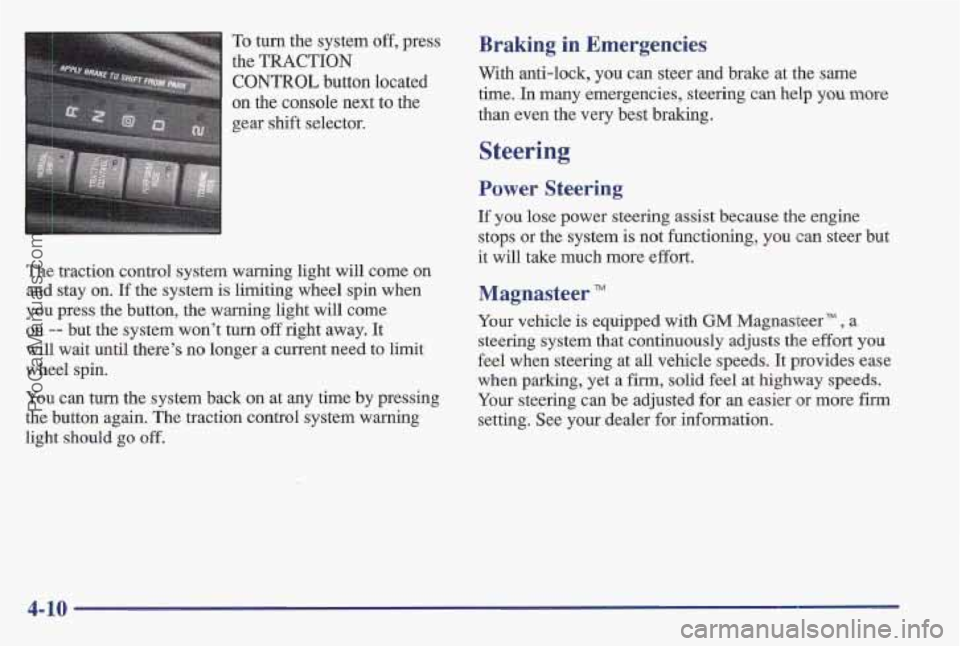
To turn the system off, press
the
TRACTION
CONTROL button located
on the console next to the
gear shift selector.
The traction control system warning light will come
on
and stay on. If the system is limiting wheel spin when
you press the button, the warning light will come
on -- but the system won’t turn off right away. It
will wait until there’s no longer a current need to limit
wheel spin.
You can
hm the system back on at my time by pressing
the button again. The traction control system warning
light should
go off.
Braking in Emergencies
With anti-lock, you can steer and brake at the same
time. In many emergencies, steering can help
you more
than even the very best braking.
Steering ~
Power Steering
If you lose power steering assist because the engine
stops or the system
is not functioning, you can steer but
it will take much more effort.
Magnasteer TM
Your vehicle is equipped with GM Magnasteer TM ? a
steering system that continuously
adjusts the effort you
feel when steering at
all vehicle speeds. It provides ease
when parking, yet a firm, solid feel at highway speeds.
Your steering can be adjusted for an easier or more firm
setting. See your dealer for information.
4- 10
ProCarManuals.com
Page 211 of 405
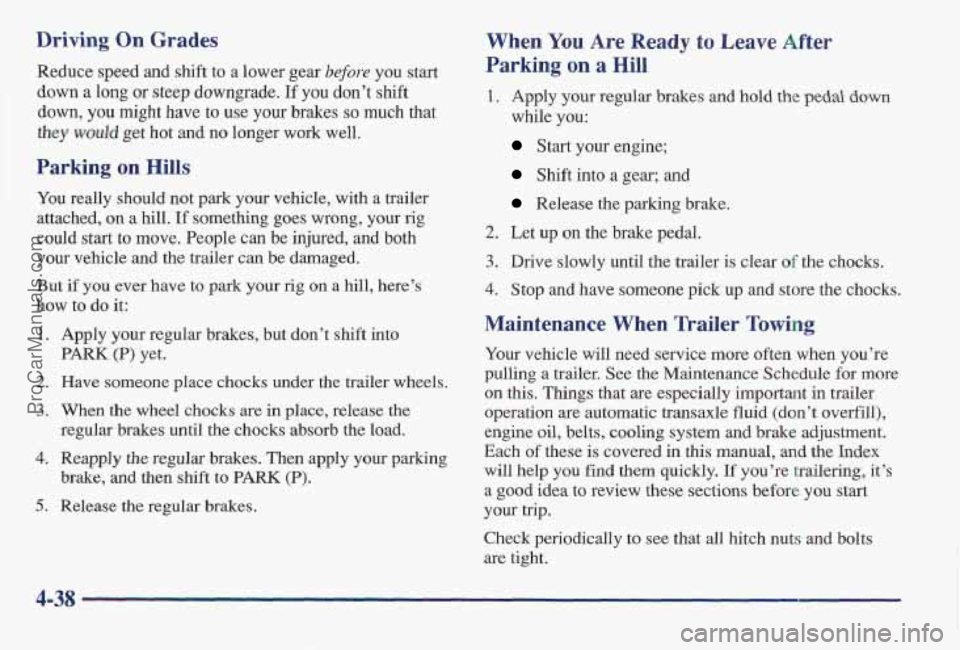
Driving On Grades
Reduce speed and shift to a lower gear before you start
down
a long or steep downgrade. If you don’t shift
down,
you might have to use your brakes so much that
they would get hot and no longer work well,
Parking on Hills
You really should not park your vehicle, with a trailer
attached,
on a hill. If something goes wrong, your rig
could start
to move. People can be injured, and both
your vehicle and the trailer can be damaged.
But
if you ever have to park your rig on a hill, here’s
how to
do it:
1.
2.
3.
4.
5.
Apply your regular brakes, but don’t shift into
PARK (P) yet.
Have someone place chocks under the trailer wheels.
When the wheel chocks are in place, release the
regular brakes until the chocks absorb the load.
Reapply the regular brakes. Then apply your parking
brake, and then shift
to PARK (P).
Release the regular brakes.
When You Are Ready to Leave After
Parking
on a Hill
1. Apply your regular brakes and hold the pedal down
while you:
Start your engine;
Shift into a gear; and
Release the parking brake.
2. Let up on the brake pedal.
3. Drive slowly until the trailer is clear of the chocks.
4. Stop and have someone pick up and store the chocks.
Maintenance When Trailer Towing
Your vehicle will need service more often when you’re
pulling a trailer. See the Maintenance Schedule for more
on this. Things that are especially important in trailer
operation are automatic transaxle fluid (don’t overfill),
engine oil, belts, cooling system and brake adjustment.
Each of these is covered in this manual, and the Index
will help you find them quickly. If you’re trailering, it’s
a good idea to review these sections before you start
your trip.
Check periodically to see that all hitch nuts and bolts
are tight.
4-38
ProCarManuals.com
Page 217 of 405
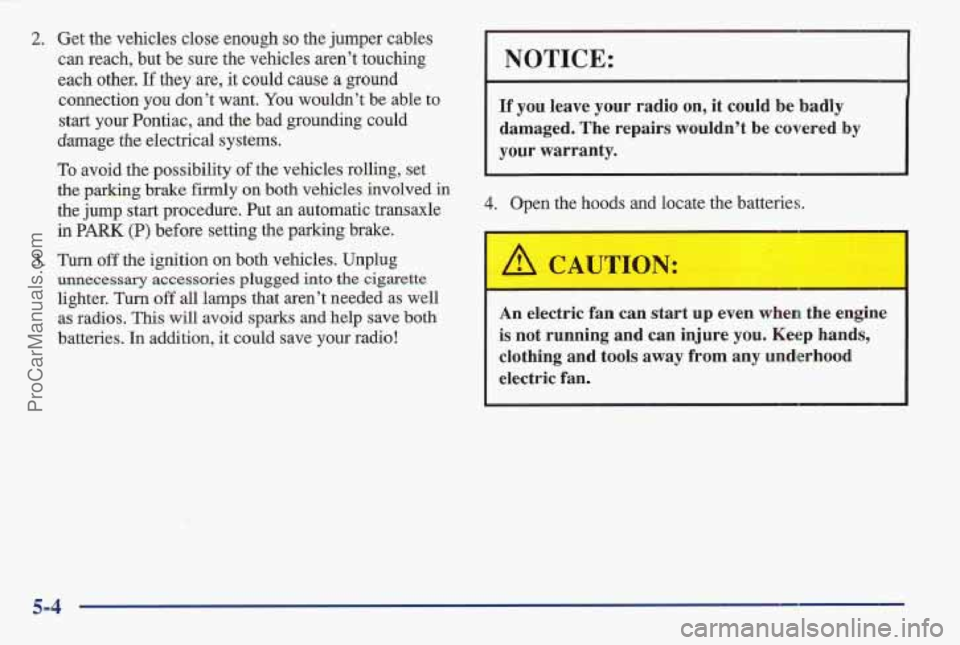
2. Get the vehicles close enough so the jumper cables
can reach, but be sure the vehicles aren’t touching
each other.
If they are, it could cause a ground
NOTICE:
connection you don’t want. You wouldn’t be able to
start
yo8ur Pontiac, and the bad grounding could
damage the electrical systems.
To avoid the possibility of the vehicles rolling, set
If you leave your radio on, it could be badly
damaged. The repairs wouldn’t be covered by
your warranty.
the parking brake firmly on both vehicles involved in
the jump start procedure. Put an automatic transaxle 4. Open the hoods and locate the batteries.
in
PARK (P) before setting the parking brake.
3. Turn off the ignition on both vehicles. Unplug
unnecessary accessories plugged into the cigarette
lighter. Turn off all lamps that aren’t needed as well
as radios, This will avoid sparks and help save both
batteries. In addition,
it could save your radio!
I 1
An electric fan can start up even when the engine
is not running and can injure you. Keep hands,
clo’thing and tools away from any underhood
electric fan,
5-4
ProCarManuals.com
Page 223 of 405

A vlehicle can fall from a car carrier if it isn’t
adequately secure’d. This can cause
a collision,
serious personal
injury and vehicle damage. The
vehicle should
be tightly secured with chains or
steel cables before it is transported.
Don’t use substitutes (ropes, leather straps,
canvas webbing, etc.) that
can be cut by s’harp
edges underneath the towed vehicle. Always use
T-hooks inserted in the T-hook slots. Never use
J-hooks.
They will damage drivetrain and
suspension components. When
your vehicle
is being towed, have the ignition key
turned to the
OFF position. The steering wheel should
be clamped in
a straight-ahead position, with a clamping
device designed for towing service.
Do not use the
vehicle’s steering column lock for this. The transaxle
should be in
NEUTRAL (N) and the parking
brake released.
Don’t have your vehicle towed on thle drive wheels,
unless you must.
If the vehicle must be towed on the
drive wheels, b’e sure to follow
the speed and distance
restrictions later in this section or your transaxle will be
damaged. If these limits must be exceeded, then the
drive wheels have to be supported on a dolly.
5-10
ProCarManuals.com
Page 239 of 405
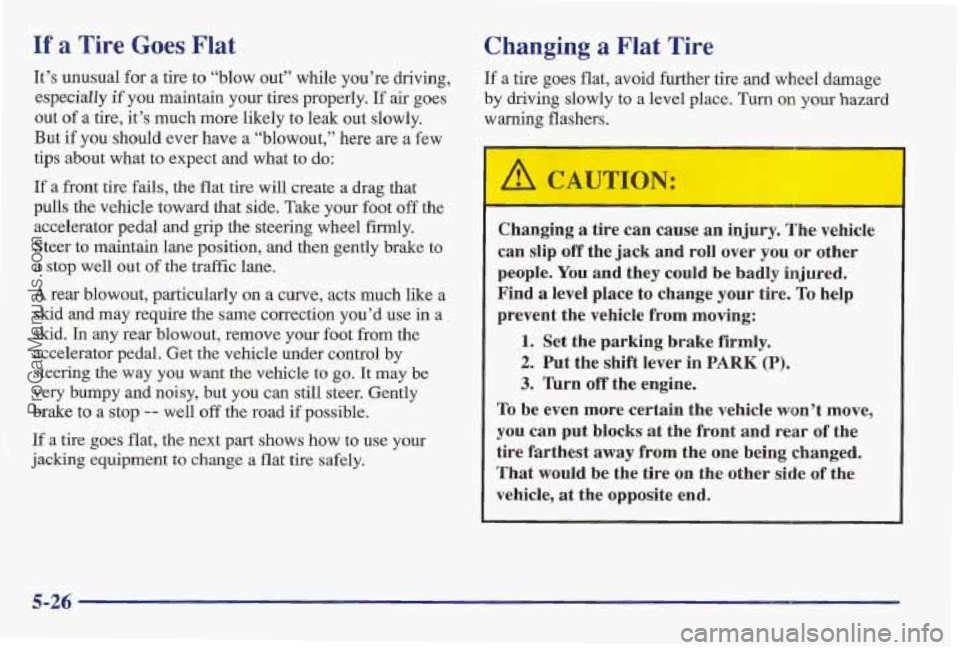
If .a Tire Goes Flat
It’s unusual for a tire to “blow out” whde you’re driving,
especially
if you maintain your tires properly. If air goes
out of a tire, it’s much more likely to leak out slowly.
But
if you should ever have a “blowout,” here are a few
tips about what to expect and what to
do:
If a front tire fails, the flat tire will create a drag that
pulls
the vehicle toward that side. Take your foot off the
accelerator pedal
and grip the steering wheel firmly.
Steer to maintain lane position, and then gently brake to
a stop well out of the traffic lane.
A rear blowout, particularly on a curve, acts much like a
skid and may require the same correction you’d use in a
skid. In any rear blowout, remove your foot from the
accelerator pedal. Get the vehicle under control
by
steering the way you want the vehicle to go. It may be
very bumpy and noisy, but you can still steer. Gently
brake to a
stop -- well off the road if possible.
If a tire goes flat, the next part shows how to use your
jacking equipment
to change a flat tire safely.
Changing a Flat Tire
If a tire goes fiat, avoid further tire and wheel damage
by driving slowly to a level place. Turn on
you. azard
w aming flashers.
Changing
a tire can cause an injury. The vehicle
can slip off the jack and roll over
you or other
people.
You and they could be badly injured.
Find
a level place to change your tire. To help
prevent the vehicle
from moving:
1. Set the parking brake firmly.
2. Put the shift lever in PARK (P).
3. Turn off the engine.
To be even more certain the vehicle won’t move,
you can put blocks at the front and rear of the
tire farthest away
from the one being changed.
That would
be the tire on the other side of the
vehicle, at the opposite end.
5-26
ProCarManuals.com